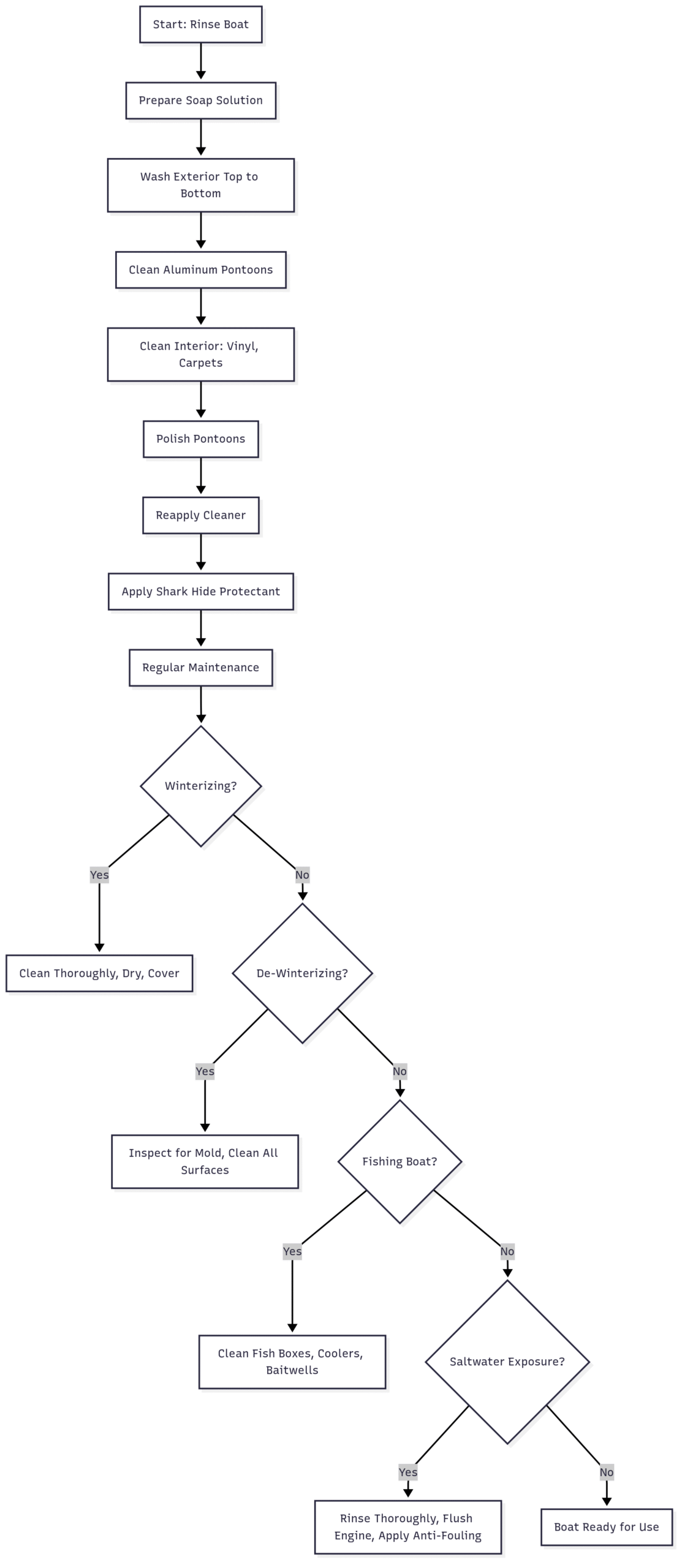How to Clean a Pontoon Boat
Learn how to clean a pontoon boat with our step-by-step guide. Keep your vessel sparkling with expert tips for aluminum, vinyl, and more.
Pontoon boats are a fantastic way to enjoy leisurely cruises on lakes, rivers, or coastal waters. Their spacious decks, comfortable seating, and versatility make them a favorite for families, fishermen, and entertainers alike. However, exposure to water, algae, saltwater, and general wear can leave your pontoon looking dull and worn. Regular cleaning not only enhances its appearance but also extends its lifespan, protects its value, and ensures it performs at its best. Whether you own a luxury Avalon or a standard model, this guide provides a detailed, step-by-step approach to cleaning your pontoon boat, including its aluminum pontoons, vinyl interiors, and flooring. We’ll also cover winterizing, de-winterizing, and cleaning after fishing or saltwater exposure, ensuring your boat remains in top condition year-round.
Why Cleaning Your Pontoon Boat Matters
Pontoon boats are exposed to harsh elements—sun, water, algae, and marine life like barnacles or mussels—that can degrade their surfaces over time. Aluminum pontoons are prone to oxidation, vinyl seats can develop mold, and flooring can harbor dirt or mildew. Regular cleaning prevents long-term damage, maintains resale value, and ensures a safe, enjoyable experience on the water. For example, neglecting saltwater residue can lead to corrosion, while ignoring algae buildup can make cleaning more labor-intensive later. By following a consistent cleaning routine, you can keep your pontoon boat looking showroom-new and performing reliably.
General Principles for Cleaning a Pontoon Boat
Before diving into the step-by-step process, let’s outline some universal principles to ensure effective and safe cleaning:
- Use Marine-Grade Products: Household cleaners like bleach or acetone can damage aluminum, vinyl, or fiberglass. Always opt for marine-grade soaps and cleaners designed for boating environments.
- Work Top to Bottom: Cleaning from the top down prevents dirty water from streaking clean areas.
- Avoid Harsh Tools: Pressure washers and abrasive brushes can damage surfaces, especially wooden decks or delicate vinyl.
- Clean Regularly: A light rinse after each outing and thorough cleaning at the start and end of the season prevent buildup.
- Protect After Cleaning: Applying protectants like Shark Hide or wax seals in your cleaning efforts and shields against UV rays and corrosion.
Step-by-Step Guide to Cleaning a Pontoon Boat
Below is a comprehensive process for cleaning your pontoon boat, covering the exterior, interior, aluminum pontoons, and flooring. This method applies to most pontoon boats, including luxury models like Avalon, which may feature fiberglass exteriors alongside aluminum pontoons.
Step 1: Rinse the Boat
Start by rinsing the entire boat with fresh water to remove loose dirt, debris, and salt residue (critical for boats used in saltwater). Use a garden hose with a gentle spray nozzle to avoid damaging surfaces. Pay special attention to the pontoons, as algae and marine growth tend to accumulate there. For boats stored at marinas, check for stubborn buildup like barnacles or zebra mussels, which may require additional scrubbing later.
Step 2: Prepare a Soap Solution
Mix a marine-grade boat soap, such as Star brite Boat Wash, with water according to the manufacturer’s instructions. Avoid household detergents, as they may contain chemicals that harm aluminum or vinyl. A one-gallon sprayer can make application easier, especially for larger boats.
Step 3: Wash the Exterior
Using a soft-bristle brush or sponge, wash the boat from top to bottom in small sections to prevent the soap from drying and leaving streaks. Focus on the deck, railings, and fiberglass components (if applicable). For fiberglass exteriors, common in luxury models, use a cleaner formulated for fiberglass to avoid scratches. Rinse each section thoroughly to remove all soap residue, as leftover soap can attract dirt.
Step 4: Clean Aluminum Pontoons
Aluminum pontoons require special care to prevent oxidation and maintain their shine. Use a cleaner specifically designed for aluminum, such as Toon-Brite Aluminum Cleaner or Aurora Boat Scrub. Apply the cleaner with a soft cloth or non-abrasive pad, working in small sections. Avoid household cleaners containing ammonia or acids, which can react with aluminum and cause pitting. For boats in the water, use a long-handled cleaning brush to scrub algae or waterline stains without applying harsh chemicals.
Step 5: Clean the Interior
The interior, including vinyl seats and upholstery, is prone to mold, mildew, and stains from spills or fishing residue. Use a vinyl-specific cleaner like 303 Marine Vinyl Cleaner. Spray the cleaner onto the seats, wipe with a soft cloth, and avoid aggressive scrubbing, which can damage the fabric. For stubborn stains, add a small amount of oxygen bleach (hydrogen peroxide-based) to the cleaning solution, but avoid chlorine bleach, which can discolor vinyl. Dry the seats thoroughly with an absorbent cloth, such as the Boat Lover’s Towel, to prevent mildew.
Step 6: Polish the Pontoons
To achieve a mirror-like finish on aluminum pontoons, polish them after cleaning. Use a marine-grade polish like Flitz Metal Polish and a microfiber cloth or polishing pad. For larger boats, an electric polisher (e.g., DeWalt or Makita) can save time. Apply the polish in circular motions or an “S” pattern to avoid streaks. This step typically takes about two hours for a standard-sized pontoon boat. Polishing not only enhances appearance but also removes minor oxidation and protects against future corrosion.
Step 7: Reapply Cleaner
After polishing, reapply the aluminum cleaner to remove any polishing residue, which can interfere with protectants. Work in sections, rinse thoroughly, and dry the pontoons completely using a highly absorbent towel. This step ensures a clean surface for the final protective layer.
Step 8: Apply a Protectant
Seal your cleaning and polishing efforts with a metal protectant like Shark Hide. This product forms a protective barrier against UV rays, saltwater, and algae, keeping pontoons shiny and corrosion-free. Apply Shark Hide with a clean cloth, following the manufacturer’s instructions, and allow it to dry completely. This step is especially critical for boats exposed to saltwater or stored outdoors.
Step 9: Regular Maintenance
To maintain your boat’s condition, rinse it lightly after every outing to remove dirt and salt. Perform a thorough cleaning at the start and end of the boating season. Vacuum carpets, wipe down furniture, and inspect for signs of wear, such as fading paint or loose fittings. Regular waxing (every 3–6 months) protects aluminum and fiberglass surfaces, while applying a UV protectant to vinyl prevents cracking.
Cleaning Specific Components
Cleaning Marine Vinyl
Vinyl flooring and upholstery are common in pontoon boats and require gentle care to avoid damage. Brush off loose dirt and rinse with a hose. Mix a warm solution of marine soap and water, and gently scrub the vinyl with a soft brush. Rinse thoroughly to remove soap residue, and air-dry to prevent mildew. For woven vinyl, address spills immediately to prevent staining, using oxygen bleach for tough spots.
Cleaning Wooden Decks
Wooden decks, found on some luxury pontoons, are vulnerable to over-cleaning. Use a gentle cleanser like ECO-100 or ECO-300, and scrub across the grain with a soft brush to avoid lifting softer wood fibers. Never scrub with the grain, as this creates ridges that trap dirt and water, promoting mold. Avoid pressure washing, which can blast away soft wood and shorten the deck’s lifespan. Rinse thoroughly and allow the wood to dry naturally.
Cleaning Carpets
Marine carpeting is durable but prone to dirt buildup. Vacuum regularly to remove loose debris, especially before washing. Use a standard carpet cleaner, following the manufacturer’s instructions, and spot-clean stains with a mild solution. Rinse thoroughly to remove soap residue, as leftover soap can attract dirt and cause stains to reappear.
Cleaning for Specific Scenarios
Winterizing Your Pontoon Boat
Winter storage requires thorough cleaning to prevent grime, algae, or marine growth from hardening. Rinse the boat to remove dirt and salt, paying attention to the pontoons and trailer bunks. Clean all surfaces with marine-grade products, and dry the boat completely before covering it. Use a breathable cover to prevent mildew, as trapping moisture can lead to mold growth. Remove barnacles or mussels, as they can damage the hull if left over winter.
De-Winterizing Your Pontoon Boat
When bringing your boat out of storage, inspect for rodents, mildew, or mold. Use a mildew-specific cleaner for fungal growth on vinyl or carpets. Clean fiberglass components with soap and water, and use an aluminum cleaner for pontoons. Check electrical connections and paintwork for damage, and repair as needed. A thorough cleaning prepares the boat for the season and ensures it’s safe to use.
Cleaning After Fishing
Fishing pontoons accumulate bait, blood, fish slime, and aquatic weeds. Clean fish boxes, coolers, and baitwells immediately after use to prevent odors and stains. Rinse the boat with fresh water, and use a marine soap solution for stubborn spots. Pay special attention to carpets and upholstery, as they can absorb fishy smells if not cleaned promptly.
Cleaning After Saltwater Exposure
Saltwater is highly corrosive to aluminum and can foster bacterial growth or marine fouling. After each saltwater outing, rinse the entire boat, including the pontoons and trailer bunks, with fresh water. Flush the engine to remove salt buildup. Dry the boat thoroughly before covering it, as coastal humidity can promote mildew. Apply anti-fouling paint and consider using zinc anodes to protect against corrosion. Regularly inspect paintwork and electrical systems for signs of wear.
Cleaning Pontoons in the Water
For boats kept in the water, cleaning the pontoons requires extra care. Use a long-handled brush to scrub off algae and waterline stains. Avoid applying soap directly in the water, as it may disrupt the aluminum’s protective oxide layer or harm the environment. Rinse with fresh water, and reserve chemical cleaners for when the boat is on land.
Tools and Products for Cleaning a Pontoon Boat
Using the right tools and products ensures efficient cleaning without damaging your boat. Below is a table of recommended products and their uses:
| Product | Use | Price (Approx.) |
|---|---|---|
| Star brite Boat Wash | General exterior cleaning | $15–$20 (1 gal) |
| Toon-Brite Aluminum Cleaner | Cleaning aluminum pontoons | $20–$25 (1 gal) |
| 303 Marine Vinyl Cleaner | Cleaning vinyl seats and flooring | $10–$15 (16 oz) |
| ECO-100 Wood Cleaner | Cleaning wooden decks | $15–$20 (1 gal) |
| Shark Hide Metal Protectant | Protecting aluminum pontoons | $30–$40 (1 qt) |
| Flitz Metal Polish | Polishing aluminum for a mirror finish | $15–$20 (5.29 oz) |
| Boat Lover’s Towel | Drying boat surfaces | $10–$15 |
| Soft-Bristle Cleaning Brush | Scrubbing exterior and pontoons | $10–$20 |
| One-Gallon Sprayer | Applying cleaners evenly | $15–$25 |
Where to Buy
These products are available at marine supply stores, online retailers like Amazon, or directly from manufacturers like CleanTools. For example, the Boat Lover’s Towel and washing mitts from CleanTools are designed for marine use and highly effective for drying and cleaning.
Process Flow for Cleaning a Pontoon Boat
To visualize the cleaning process, here’s a flowchart outlining the steps:

This flowchart ensures you follow the correct sequence and account for specific scenarios like winterizing or saltwater cleaning.
Common Mistakes to Avoid
- Using Household Cleaners: Products like bleach, acetone, or gasoline can strip paint or damage aluminum and vinyl.
- Pressure Washing: High-pressure water can harm wooden decks, vinyl, or delicate fittings.
- Scrubbing Wood with the Grain: This lifts soft wood fibers, creating a rough surface prone to mold.
- Covering a Wet Boat: Trapping moisture promotes mildew and corrosion.
- Neglecting Regular Rinses: Failing to rinse after outings allows dirt and salt to accumulate.
Maintaining Your Pontoon Boat’s Value
Regular cleaning not only keeps your pontoon boat looking great but also preserves its resale value. Aluminum pontoons free of oxidation, clean vinyl interiors, and well-maintained flooring signal a well-cared-for vessel. Applying protectants like Shark Hide and waxing every 3–6 months further enhances durability. For luxury models like Avalon, which may feature fiberglass exteriors, proper cleaning ensures the boat remains a standout on the water.
Conclusion
Cleaning a pontoon boat is a straightforward but essential task that protects your investment and enhances your boating experience. By following the steps outlined—rinsing, washing, polishing, and protecting—you can keep your pontoon sparkling and corrosion-free. Use marine-grade products, avoid harsh chemicals or tools, and tailor your cleaning routine to your boat’s materials and usage (e.g., fishing or saltwater). With the right tools, like those from CleanTools, and a consistent maintenance schedule, your pontoon boat will remain a source of pride and enjoyment for years to come. Whether you’re cruising a lake or preparing for winter storage, a clean pontoon is a happy pontoon.
Share How to Clean a Pontoon Boat with your friends and Leave a comment below with your thoughts.
Read How to Shrink Wrap a Pontoon Boat? until we meet in the next article.






